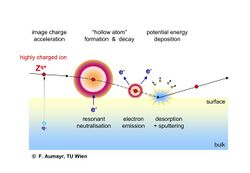Physics:Hollow atoms
Hollow Atoms (discovered in 1990 by a French team of researchers around Jean-Pierre Briand) are short-lived multiply excited neutral atoms which carry a large part of their Z electrons (Z ... projectile nuclear charge) in high-n levels while inner shells remain (transiently) empty. The hollow atoms are exotic atomic species whose all, or most, electrons lie in excited states, while the innermost shells are empty.[1] These atomic species were first observed during the interaction of highly charged ions with surfaces.[2] population inversion arises for typically 100 femtoseconds during the interaction of a slow highly charged ion (HCI) with a solid surface.
Despite this limited lifetime, the formation and decay of a hollow atom can be conveniently studied from ejected electrons and soft X-rays, and the trajectories, energy loss and final charge state distribution of surface-scattered projectiles. For impact on insulator surfaces the potential energy contained by hollow atom may also cause the release of target atoms and -ions via potential sputtering and the formation of nanostructures on a surface.
External links
- Review article on hollow atoms.
- EU Network ITS-LEIF
- MPI Heidelberg, Germany
- NIST, USA
- TU Wien, Austria
References
- ↑ Briand, J. -P; Le Roux, V; Béchu, N; Dreuil, S; Machicoane, G; Prior, M; Xie, Z (3 June 1999). "The hollow atoms" (in en). Nuclear Instruments and Methods in Physics Research Section B: Beam Interactions with Materials and Atoms 154 (1–4): 166–173. doi:10.1016/S0168-583X(99)00192-5. Bibcode: 1999NIMPB.154..166B. https://www.sciencedirect.com/science/article/abs/pii/S0168583X99001925. Retrieved 4 June 2022.
- ↑ Briand, J. P.; de Billy, L.; Charles, P.; Essabaa, S.; Briand, P.; Geller, R.; Desclaux, J. P.; Bliman, S. et al. (9 July 1990). "Production of hollow atoms by the excitation of highly charged ions in interaction with a metallic surface". Physical Review Letters 65 (2): 159–162. doi:10.1103/PhysRevLett.65.159. PMID 10042568. Bibcode: 1990PhRvL..65..159B. https://link.aps.org/doi/10.1103/PhysRevLett.65.159. Retrieved 4 June 2022.


